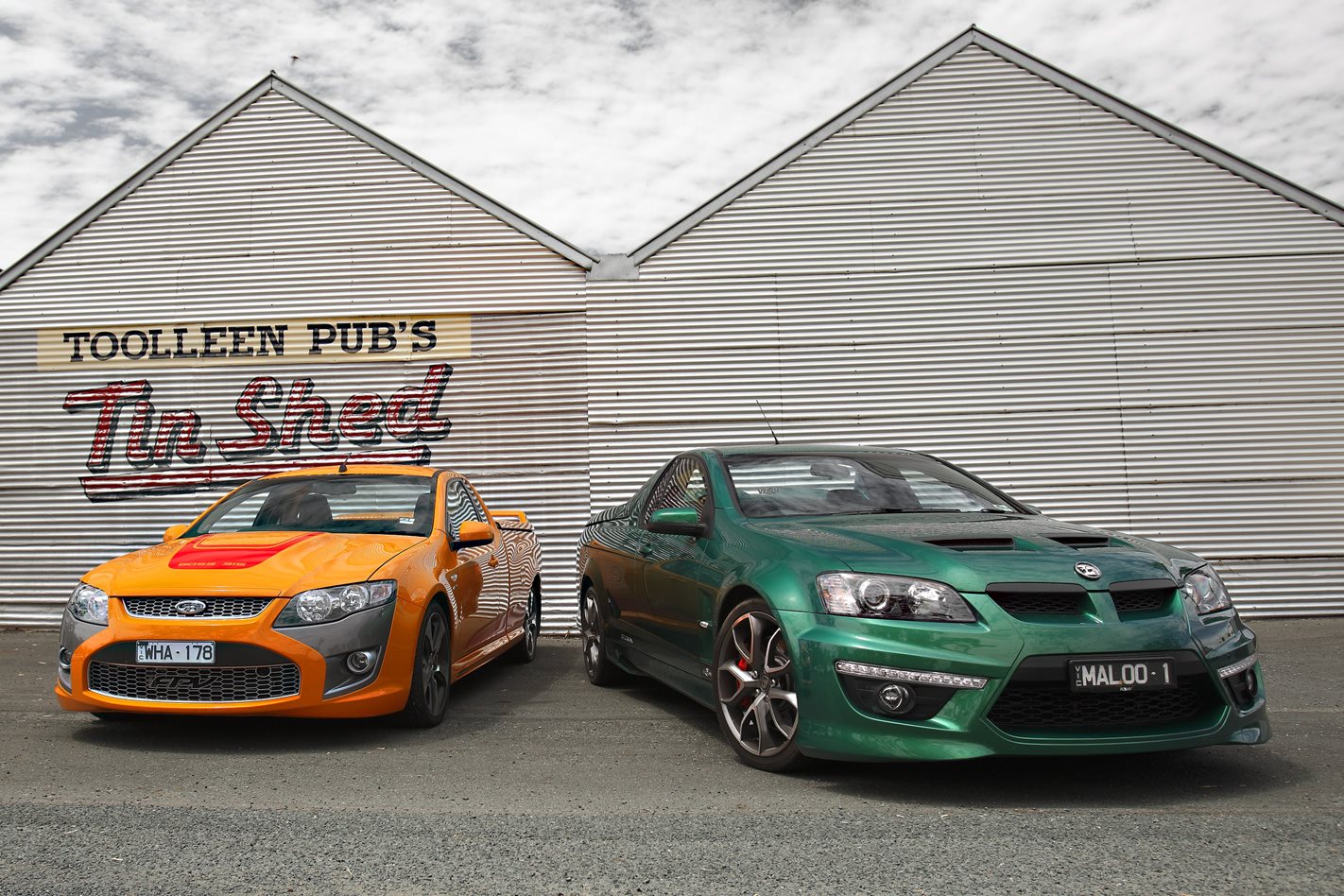Utes sure as hell ain’t what they used to be.
Part of the local landscape since the 1930s, the humble Australian tray-back has evolved way beyond any vision its originators might have had for it. The modern ute is, of course, a product of its times. And with fringe benefits tax legislation favouring commercial vehicles and pastimes such as dirt-biking flourishing, it’s no wonder that both HSV and FPV have offered up high-performance toy-haulers for tradies with a bit more gold to splash around.
While it’s true that all vehicles have expanded their performance envelopes over time and that niche marketing has led to a whole raft of new market segments, I’d still love to see the look on Lew Bandt’s face (the Ford engineer who designed the first ute back in the 30s) if he was to gaze down and spot either of this pair.
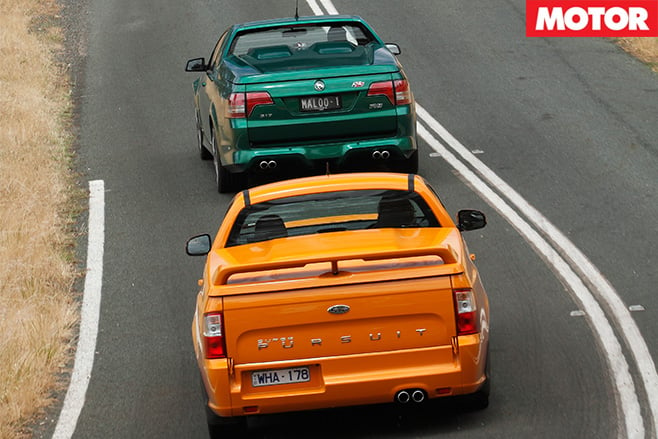
Of course, it’s not quite that straightforward, with the Henry running quad overhead camshafts and the LS3 sticking with a relatively simple single cam and pushrod valve operation.
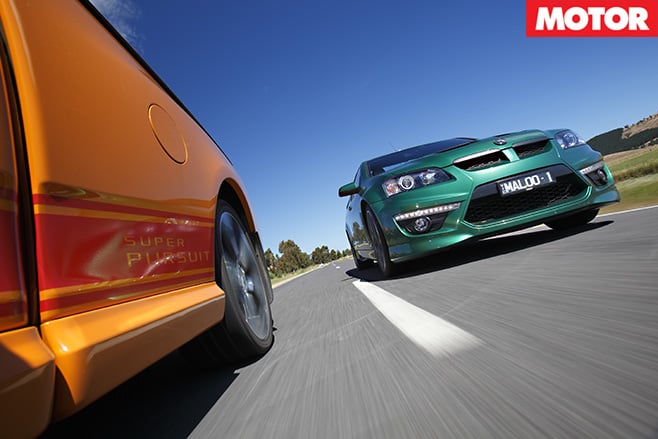
Thing is, that’s not as quick as we’d hoped. And the 0-100km/h time of six seconds dead was also something of a let-down. But what we really didn’t see coming was how small the gap back to the FPV was. Okay, the Super Pursuit test car is an auto and everything, but 0-100km/h in 6.4 and a standing 400m of 14.5 at 166.2km/h is as close to its HSV opposite number as it’s ever been.
What the drag strip masks is the real difference in these engines. See, while the power and torque peaks might be in the same ballpark, the way and the where of those output deliveries is the critical difference. The defining difference, in fact.
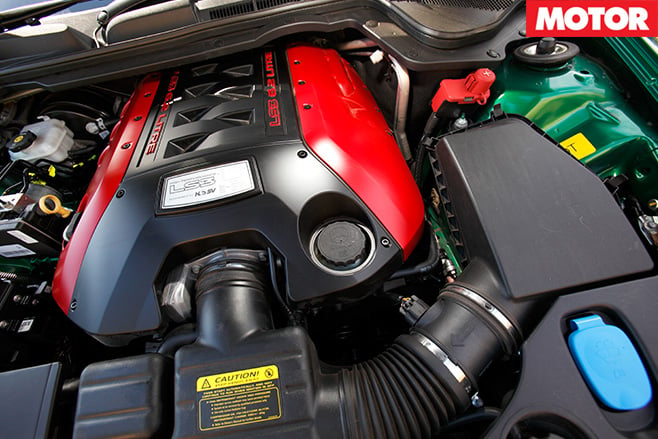
You can really see the difference in the 80-120km/h times in the various gears. While the HSV’s ultra-long sixth gear nobbles it from 80km/h up, in both fourth and fifth cogs the Maloo beats the Super Pursuit to 120km/h by almost two and three seconds respectively. Even held in third gear, where the FPV is spinning closer to its engine’s high-rpm sweet spot, the HSV is still nearly a second-and-a-half swifter to 120.
On the road there’s a marked difference, with the HSV literally pulling yards on the FPV when cranking out of corners. By the time the FPV has swung its tacho beyond 4500rpm, it’s starting to honk, but it’s too little too late, and the Maloo is already much closer to the far horizon.
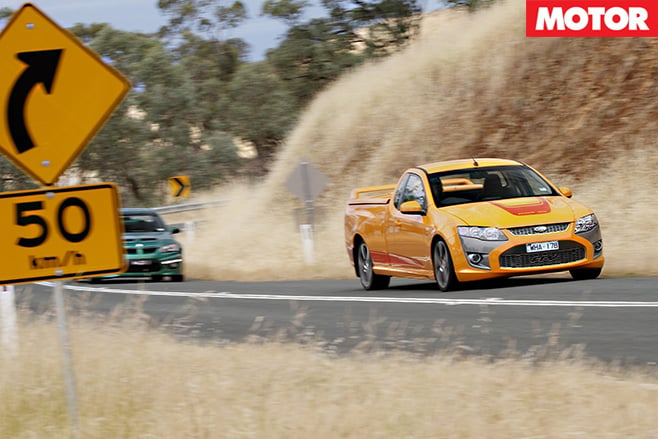
Neither car feels especially light or agile on the road, although the HSV does have an extra dollop of steering feel thrown in to make you a bit more certain that those big front tyres have bitten and are likely to hang on. It’s also quieter on the road, and while both are pretty good in suspension-noise terms, the FPV gets a fair din going that enters the cabin from behind the seats.
The theory is that there are little vents built into the FPV’s cabin that are designed to vent pressure in the case of the airbags deploying (otherwise you’d have ruptured ear drums, apparently). And these leak noise into the cab when you’re on the move.

Even then, the HSV is a more natural oversteerer, but that’s only late in the piece using plenty of throttle on a corner’s exit. Up until then, especially in the mid-corner, the HSV is really quite a neutral beast.
In ride terms, the Maloo continues to surprise by being more supple on the sort of crumbly back roads either ute is likely to find owners wanting to travel along. There’s good damping and, even though the Maloo doesn’t get the GTS’ MRC dampers, the basic set-up is sound.
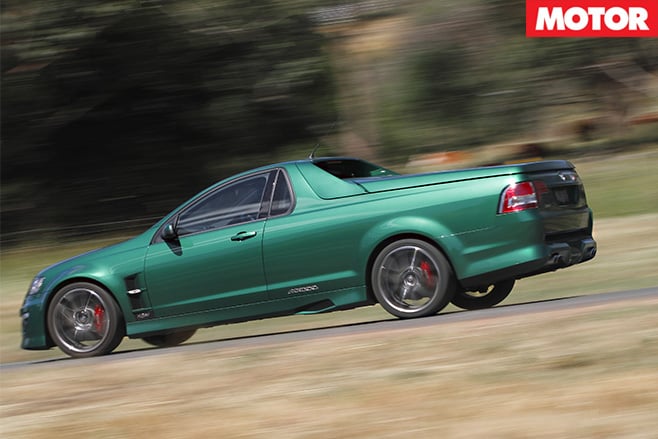
Braking? Both utes are extremely well endowed; the FPV copping six-pot front Brembos and the HSV large front four-potters. And while the Maloo stopped just over a metre-and-a-half shorter, that’s possibly down to tyres rather than hardware. Both make good use of their wheelbases, too, to remain surefooted under heavy braking, and mashing either’s brake pedal into the carpet is a simple, stress-free exercise.
Neither ute is likely to be used for actually carrying too much – a dirt bike, an Esky and a swag are the most likely tray-loaded items. So you’d reckon the FPV’s cart-sprung live-axle rear end would give it some degree of payload advantage.
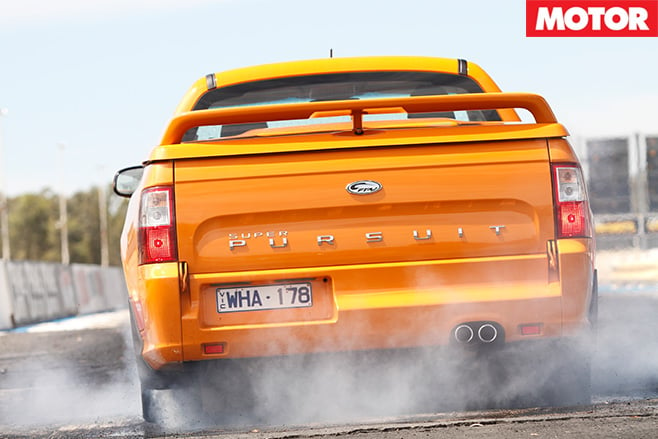
At least both vehicles now feature tough, plastic tray liners, which will neither rust nor dent. But those of us who still use utes as utes shake our heads at the hard tonneaus that seriously limit what you can actually carry without actually removing the cover and leaving it at home (an exercise that isn’t some quick one-bloke job, either).
The HSV’s gearshift is still a bit heavy and slow for some tastes, though at least the clutch is relatively light and has plenty of feel. I’m not convinced that the FPV’s otherwise very good six-speed auto is such a magically intuitive match with the V8, either – particularly compared with the sweeter turbo-six/auto combination – but it is preferable to the manual in terms of day-to-day running around and towing, roles of which this pair would both be marvellous at playing.

That, however, is not the FPV’s major user interface blow-out. Nope, the big clanger would have to be the seating position. Look, the seats themselves are wonderful things, with nice high bolsters and plenty of padding in the right places. But the damn steering column is adjustable to an infinite number of positions, all of them way too low.
The upshot is that it becomes a knee-banging chore trying to swing your legs under the steering wheel getting in and out, and it absolutely ruins the experience of sportiness because it makes you feel like you’re sitting on top of the car, rather than in it. Oh, and if the driver’s airbag ever goes off, the wheel is so low that should anybody ever produce ‘Bee Gees – The Musical’, you’ll be able to sing all of Barry’s high parts without trying.
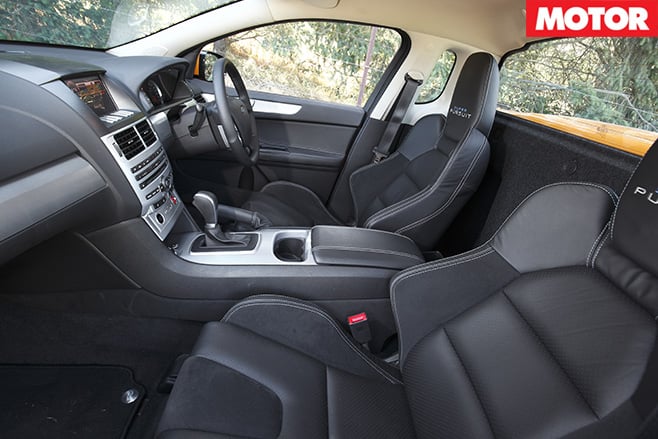
That said, the FPV interior is better screwed together than the HSV’s (the VE and its offspring have always been a bit ordinary in this department). And at least you can actually see out of the Super Pursuit…
Ah yes, vision. I’m going to go out on a limb here and suggest that I can’t think of another current production car – and that’s including the Lamborghini Gallardo – that is so impossible to see out of as the current Maloo R8. And I’m not some small sunk-in-the-pew bloke, either.
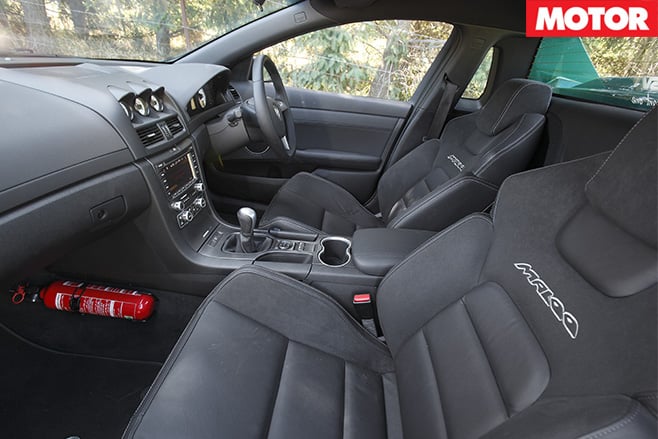
A small car could drive right past your tail-gate while you’re reversing and you wouldn’t know until you’d heard it go ‘crunch’. In fact, you’ll have trouble even seeing the point of brushing your teeth and being good to your mother from the cabin of this thing.
In traffic, you’re never really sure what’s around you and, consequently, lane-changes are never as confident as they should be. In fact, the lack of vision in the Maloo would be an absolute deal-breaker for me, regardless of how good it is at everything else.
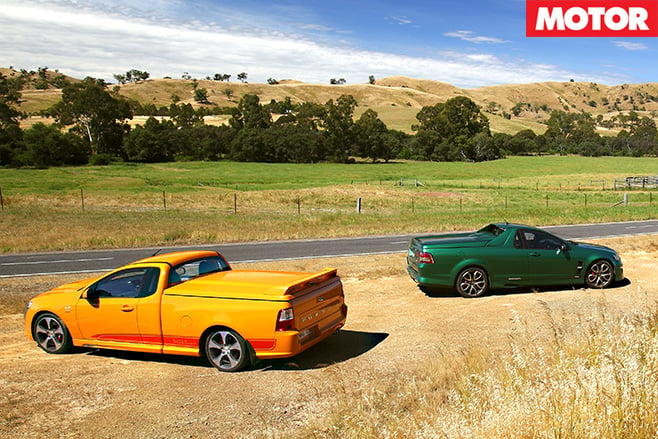
While I’m at it, who told FPV that pumping the ute’s rear wheel arches but leaving the same width rear axle in place was okay? It looks seriously wrong with the anaemic 245mm tyres tucked way up underneath. Maybe it’d be better if the FPV had the HSV’s fatter rear hoops, but it doesn’t, and that sort of sums up the whole thing.
I can see that the Maloo is a sometimes-misguided attempt at a sporting ute for the chippie or sparky who’s done good. But even at $63,990 compared with the Maloo’s $62,500 (manual) and $64,500 (auto) asks, the Super Pursuit feels much more like a parts-bin special.
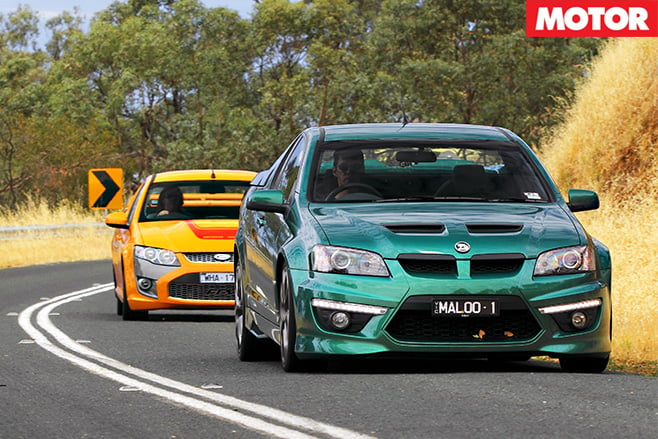
All of which kind of hands victory to the Maloo, because even though it’s a black hole to sit in, it does have the best engine, the best ride-handling package, and it does offer the superior driving experience.
And even the dimmest apprentice can see how that adds up. He just won’t be able to see it – or much else, for that matter – from the HSV’s driver’s seat.
Way back
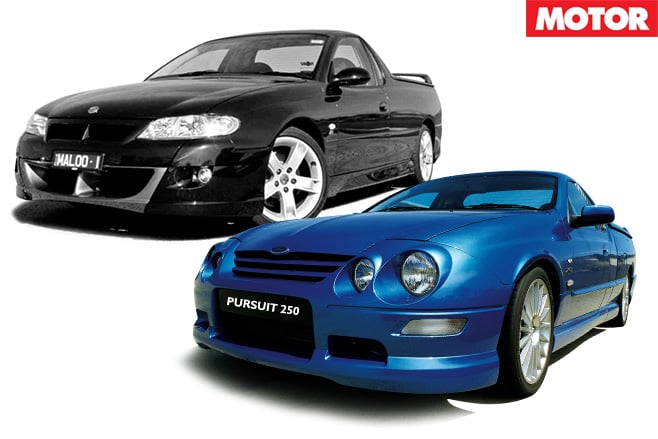
That final 5.6-litre V8 might have sounded a bit gruff at the top end, but in its 3000-5000rpm pleasure zone, with all that torque and all that old-school rumble, the Pursuit 250 was rock and roll, baby.
HSV’s first new Maloo of the decade, the VU and VUII (both 2001) was the first based on Holden’s all-new Ute. An IRS rear end (albeit of the old semi-trailing-arm variety) gave the Maloo a sizeable leg-up over the Pursuit, but its LS1 Chev’ V8 couldn’t match the Windsor’s torque, and its cabin couldn’t match the Ford’s room. Looked bloody tough, though…
Specs
| u00a0 | FPV Super Pursuit | HSV Maloo R8 |
| Body | 2-door, 2-seat utility | 2-door, 2-seat utility |
| Drive | rear-wheel | rear-wheel |
| Engine | 90-degree V8, DOHC, 32v | 90-degree V8, OHV, 16v |
| Material | alloy head/iron block | alloy head/alloy block |
| Bore/stroke | 90.2 x 105.8mm | 103.25 x 92.0mm |
| Capacity | 5408cc | 6162cc |
| Compression | 10.8:1 | 10.7:1 |
| Power | 315kW @ 6500rpm | 317kW @ 6000rpm |
| Torque | 551Nm @ 4750rpm | 550Nm @ 4600rpm |
| Redline/Cut | none/6500rpm | none/6600rpm |
| Fuel/tank | 98 octane/81 litres | 98 octane/73 litres |
| ADR Consumption | 14.4L/100km | 15.1L/100km |
| Kerb weight | 1893kg | 1823kg |
| Power/Weight | 166kW/tonne | 174kW/tonne |
| Transmission | 6-speed automatic | 6-speed manual |
| Ratios | 4.17/2.34/1.52/1.14/0.87/0.69 | 3.01/2.07/1.43/1.00/0.84/0.57 |
| Final drive | 2.73 (LSD) | 3.70 (LSD) |
| Suspension | double A-arms, coil springs, anti-roll bar (f); live axle, leaf springs, anti-roll bar (r) | struts, A-arms, anti-roll bar (f); multi-links, coil springs, anti-roll bar (r) |
| L/W/H | 5096/1934/1453mm | 5121/1899/1465mm |
| Wheelbase | 3104mm | 3009mm |
| Tracks (f/r) | 1583/1583mm | 1592/1590mm |
| Steering | power rack and pinion | power rack and pinion |
| Turning circle | 11.8m | 11.4m |
| Lock-to-lock | 2.6 turns | 2.8 turns |
| Brakes | 355mm ventilated/drilled discs, six-piston calipers (f); 328mm ventilated/drilled discs, single-piston calipers (r); ABS, EBD, ESP | 365mm ventilated discs, four-piston calipers (f); 350mm ventilated discs, four-piston calipers (r); ABS, EBD, ESP |
| Wheels | 19 x 8.0-inch, alloy | 20 x 8.0-inch (f), 20 x 9.5-inch; alloy |
| Tyres | Dunlop SP Sport Maxx | Bridgestone Potenza RE050A |
| Tyre size | 245/35ZR19 | 245/35R20 98Y (f), 275/30R20 96Y (r) |
| Price | $63,990 (as tested) | $70,130 (as tested) |
| Pros | Strong top-end grunt, superb GT-P seats, decent value | Monster engine, manly looks, impressive dynamic package |
| Cons | Lacks HSVu2019s mid-range, Ford suspension tune needs work | Youu2019ll either love or loathe the looks, terrible outward vision |
| Star Rating | 6/10 | 7/10 |
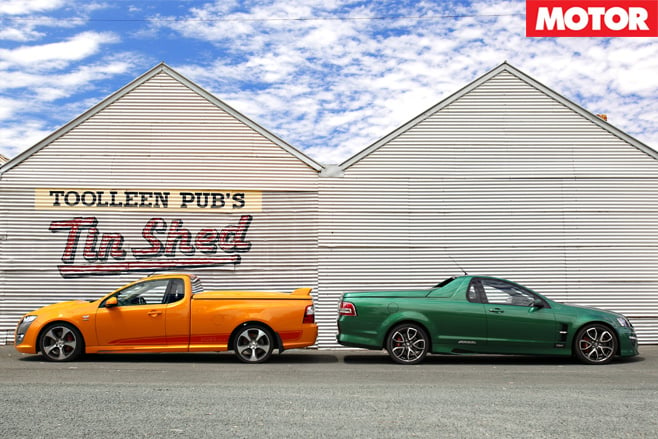
| u00a0 | FPV Super Pursuit | HSV Maloo R8 |
| 0-10km/h | 0.6sec | 0.4sec |
| 0-20km/h | 1.1sec | 0.9sec |
| 0-30km/h | 1.8sec | 1.5sec |
| 0-40km/h | 2.4sec | 2.1sec |
| 0-50km/h | 2.9sec | 2.6sec |
| 0-60km/h | 3.4sec | 3.0sec |
| 0-70km/h | 4.1sec | 3.6sec |
| 0-80km/h | 4.9sec | 4.6sec |
| 0-90km/h | 5.6sec | 5.3sec |
| 0-100km/h | 6.4sec | 6.0sec |
| 0-110km/h | 7.3sec | 7.4sec |
| 0-120km/h | 8.3sec | 8.3sec |
| 0-130km/h | 9.5sec | 9.2sec |
| 0-140km/h | 10.8sec | 10.2sec |
| 0-150km/h | 12.1sec | 11.3sec |
| 0-160km/h | 13.5sec | 12.1sec |
| 0-170km/h | 15.1sec | 14.6sec |
400m | 14.5 @ 166.2km/h | 14.2 @ 167.3km/h |
80-120km/h (3rd) | 4.9sec | 3.5sec |
80-120km/h (4th) | 7.1sec | 5.3sec |
80-120km/h (5th) | 9.9sec | 7.0sec |
80-120km/h (6th) | 10.9sec | 12.6sec |
100-0km/h | 37.9m | 36.2m |
*Driver David Morley @ Heathcote Dragway

